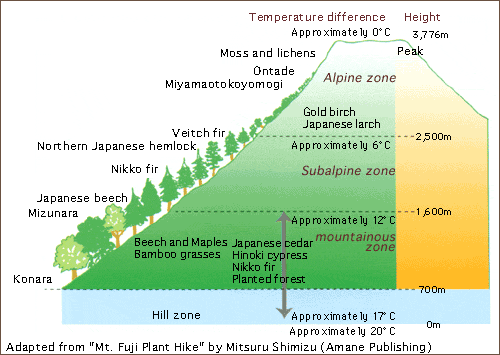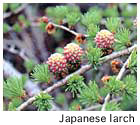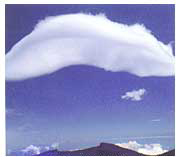There are many actions taken by the Japanese government, private companies and also little efforts done by the climbers to protect the natural environment of Mount Fuji.
The Japanese government
The Shizuoka Prefecture and Yamanashi Prefecture have decided to deal with the conservation of Mount Fuji in cooperatively. They have set up a charter to protect the beautiful nature of Mount Fuji.

- Learn about and be familiar with the nature of Mt.Fuji and be thankful for its abundant gifts.
- Cherish and protect its beautiful nature, thus cultivating an enriched culture.
- Strive to reduce the burdens on the natural environment and live in harmony with Mt. Fuji.
- Each individual should actively work towards preservation of its environment.
- Pass on the nature,scenery,history and culture of Mt.Fuji to future generation.
Private Companies

 Toyota Tsusho and Nikon has been taking part in the Mount Fuji Forest Reforestation Project devised by the OISCA-International in collaboration with Yamanashi Prefecture. Both private companies sent employees and their families to participate in the project. They helped to plant trees and also clear underbrush at Mount Fuji.
Toyota Tsusho and Nikon has been taking part in the Mount Fuji Forest Reforestation Project devised by the OISCA-International in collaboration with Yamanashi Prefecture. Both private companies sent employees and their families to participate in the project. They helped to plant trees and also clear underbrush at Mount Fuji.Climbers
The Japanese government have set up a Mount Fuji Guide for the climbers to follow. This guide is the rules when climbing Mount Fuji. The rules are shown below.
- Bring back your own garbage, pick up other people's
Climbers are asked to bring back their own garbage. Please also pick up trash on the trail even if they are not yours. Your cooperation is essential to keep the mountain clean.
- Bring a portable ashtray
If you are a smoker, please bring a portable ashtray and refrain from littering.
- Do not deviate from trails
Anywhere outside of the trails is unstable. Walking such a place is dangerous, and it may even trigger a rock fall. You might also damage the unique vegetation of Mt. Fuji.
- Put a cap on the pole
The surface of Mt. Fuji is crumbling. Please put a cap on the tip of your pole in order to prevent erosion of the trails.
- Do not bring pets
Your pets may cause some effects on animals and plants of Mt. Fuji. Please do not bring your pets in order to conserve the natural environment and protect wild animals.
- Refrain from capturing animals, gathering plants or sampling rocks
Mt. Fuji is designated as a special conservation area. The following activities are prohibited in such areas.
- Gathering or damaging plants
- Capturing or damaging animas
- Sampling soil or rocks
- Making bond fire
You will be punished severely if you commit any of them without permission.
- Gathering or damaging plants
- Capturing or damaging animas
- Sampling soil or rocks
- Making bond fire
You will be punished severely if you commit any of them without permission.
- No graffiti
Do not draw graffiti on the buildings or rocks of Mt. Fuji. Placing rocks to represent words or a picture is also prohibited. These behaviors not only destroy the scenery, but also exert a harmful effect on creatures living in this unusual environment.
- Keep the toilets clean
The toilets on the mountain are environment-friendly bio-toilets.
The usage of a toilet differs depending on its type. Follow the instructions in the toilet or mountain huts. Only toilet paper and water soluble tissue paper are allowed.
Most of toilets on Mt. Fuji are maintained by tips. Please leave your tip when you use them. (An average tip is 200 yen.)
The usage of a toilet differs depending on its type. Follow the instructions in the toilet or mountain huts. Only toilet paper and water soluble tissue paper are allowed.
Most of toilets on Mt. Fuji are maintained by tips. Please leave your tip when you use them. (An average tip is 200 yen.)
- No idling
Idling causes air pollution and have harmful influence on the ecosystem.
Please do not leave the engine idling in order to protect the beauty of Mt. Fuji.
Please do not leave the engine idling in order to protect the beauty of Mt. Fuji.
- Automobile restriction
The upper half of Mt. Fuji is designated as a special area by Natural Parks Law, and entering by automobile is prohibited.
If every climber follow the rules in the guide, even though it is only a little effort, they can contribute to the conservation of Mount Fuji.



0108c18.jpg)


